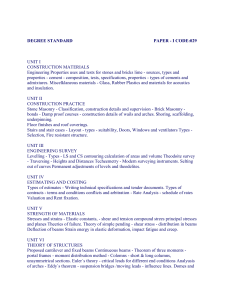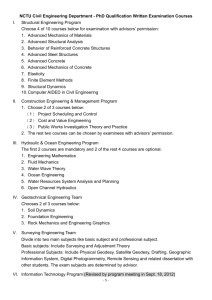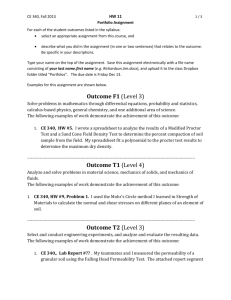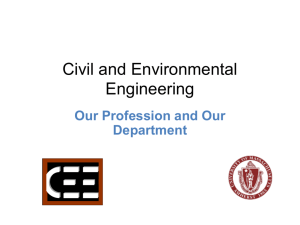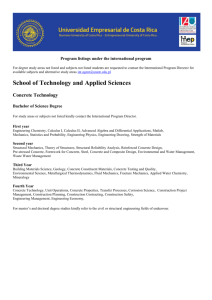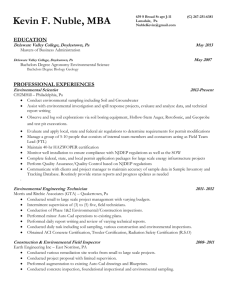B-TECH Mechanical
advertisement
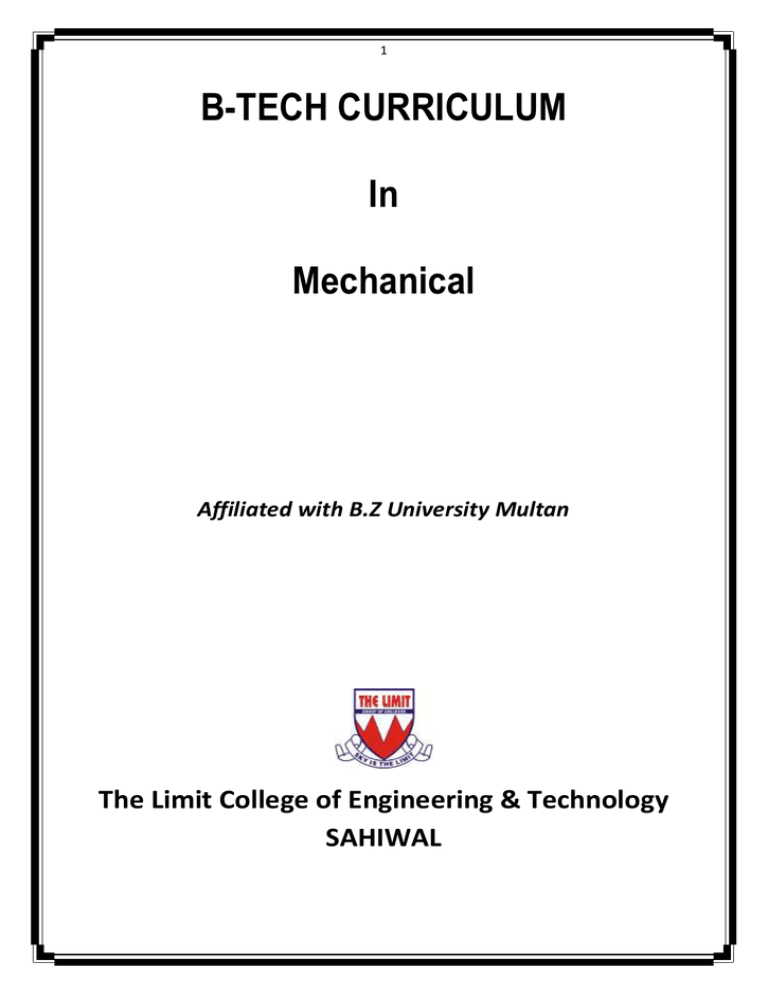
1 B-TECH CURRICULUM In Mechanical Affiliated with B.Z University Multan The Limit College of Engineering & Technology SAHIWAL 2 SCHEME OF STUDIES OF B. TECH (PASS) MECHANICAL TECHNOLOGY Sr# 1. 2. 3. 4. 5. 6. 7. 8. 9. 10. 11. Code# BT(MT)113 BT(MT)132 BT(MT)142 BT(MT)153 BT(MT)163 BT(MT)123 BT(MT)173 BT(Math)112 BT(BCS)112 BT(BIP)111 BT(MT)182 Title Mechanics of materials Industrial management Industrial economics Metrology and gauging Tool design and machines tool Mechanics of machines CND machines Applied mathematics Communication skill Islamiyat and pak studies Project T 2 2 2 2 2 2 2 2 2 1 0 19 P 3 0 0 3 3 3 3 0 0 0 6 21 C 3 2 2 3 3 3 2 2 2 1 2 26 Marks 100 100 100 100 100 100 100 100 100 50 0 950 Total 50 150 0 100 0 100 50 150 50 150 50 150 50 150 0 100 0 100 0 50 100 100 350 1300 3 MECHANICS OF MATERIALS (MT-113) Course Contents i) Simple stress Introduction, basic types of stress, bearing stress, thermal stress, bearing stress, thermal stress, ii) Simple strain Concept of strain and its basic types, hooke’s law, factor of safety, peissea’s ratio, elastic versus plastic behavior of a material. iii) Geometrical properties of areas Moment of simple regular areas and composite areas, centroid of a composite area, 2nd moment of regular simpler areas, parallel-axis theorem and 2nd moment of composite area. Polar moment of intertia and perpendicular axis theorem. iv) Tersion of circular shafts Basic, assumptions for torsional formula, torsional formula, relation between power transmitted and the tersional formula, applications of torsional formula, the solution of problems. v) Beanas shearing force and bending moments Introduction and types, shearing force in statically determinante beams Bending moment in beams Bearing flexural stresses vi) Derivation of flexural forula, determination of flexural stress in statically determine beams vii) Beans: Measurement of deflection Double integration method and macaulay’s method of superposition, introduction to moment area theorems. viii) Strain energy methods The concept of strain energy elastic strain energy castigliano’s Theorem and its applications ix) Columns Introduction, euler’s formula design of columns for centric and eccentric loads Text Books Beer F.P and Johnston R. MECHANICS OF MATERIAI’S. McGraw Hill Book Company UK Reference books 1. Nash W. Schaunfs outline of strength of mmaterials McGraw Hill Book Company. UK 2. Benhan P.P and Crawford R.J. Englineering Mechanics of 4 B. Math 112 Mathematics Objectives i) ii) iii) iv) To review the knowledge and practice the skill acquired in diploma courses. To understand the concept and use of different equation. To learn different methods to solve differential equations. To understand the concept of complex numbers and their application. Description The course aims at the learning of different mathematics skills and their application in solving technical problems. Contents 1. Trigonometry: plane trigonometry, solution of triangles, trigonometric equation. 2. Algebra: Revision of the solution of quadratic equations, reducible to the quadratic forms. Cube root unity. Relation between roots and coefficient of quadratic equation. The discriminant, nature of roots, writing equation from the roots. Simultaneous quadratic equation, cubic equation, graphic method, partial fraction, revision of A.P and G.P, definition of H.P, Arithmetic, geometric and harmonic means, mixed progression, approximation with the help of binomial theorem. 3. Function: Exponential and logarithmic function, hyperbolic and inverse hyperbolic functions, relation between circular and hyperbolic functions. 4. Determinants and matrices: Determinants, simple properties and their application to solution of system of equations, algebra of matrices and their application to solution of system of equations. 5. Complex numbers: Argand diagram, operation with complex numbers, and their geometrical interpretations, demoiver’s theorem (Proof for rational index only), trigonometric and hyperbolic functions of complex variables. 6. Coordinate geometry: Revision of the equation of straight line, angle between two straight lines, distance of a point from straight line, equation of a circle, parabola and ellipse, hyperbola, definition equations, asymptotes, simple properties of the parabola ellipse, and hyperbola, solid geometry of line, plane and sphere. 7. Differential calculus: Function limit, different coefficients, differentiation of simple algebraic, trigonometric, exponential, logarithmic and hyperbolic functions, rule of differentiation, partial differentiation, Taylor’s and machlaurin theoriem, and the deduction of binomial exponential and logarithmic series and expansions of sinx cosx. 5 8. Integral calculus: Integration as inverse of differentiation, fundamental formulae of integration, general rules, integration by substitution and by parts, use of partial fraction, define integration, double integration. 9. Application of calculus: Slope of curve maxima and minima, small increments and errors, length of an area, area under curve, areas of surfaces and volume of solids of revolution, theorem of pappus and gulidinus, centroid, velocity, acceleration, momentum, a rotating body, moment of inertia, theorem of parallel and perpendicular axes, mean and root mean square values, curvature and radius of curvature. 10. Differential equations: First order and first degree, linear equation of second order with constant coefficients, operator, complementary function and partial integral. 11. Vector: Addition and subtraction of vectors, scalar and vector products, differentiation and integration of vectors. Reference books 1. Calculus and analytic geometry by Thomas latest edition. 2. Modern algebra and trigonometry by S.M. Yousaf. 6 BCH-113 advance surveying and advance construction Objectives i) ii) iii) To develop and understanding of surveying and leveling theory and practice. To produce an ability to translate survey information for design and construction purpose. To develop a skill in the use of survey instruments. Description The course provides an overview of surveying and leveling practice and demonstrates an understanding of area control by theodolite and compass. It explains the methods of establishing the contours of an area by field exercise. It includes exercises in setting out and controlling complex construction works. Contents 1. Survey instruments: Study and use of conventional surveying instruments and EDM devices. 2. Triangulation and traversing: Station selection, base line measurement, computations, adjustment, plotting and detailing of triangulation/trilateral schemes, total station GPS. 3. Leveling: ordinary level leveling, precise leveling, profile leveling, errors and connection in leveling, plotting longitudinal and cross section of leveling. Trigonometric leveling. 4. Tachometry: System of tachometry, application of tachometry in surveying, computation. 5. Setting out curves: Setting out curves (horizontal, vertical, transitional), demarcation of buildings and bridges, sewer lines, rout lines, tunnel etc. 6. Base line measurement: Importance, methods, and equipment for base line. 7. Hydrographic surveying: Introduction to hydrographic surveying, sounding methods. 8. Advance construction: Foundation for walls and piers. Load bearing walls in brick and masonry construction, composite walls, cavity construction, concrete framed structures, panel walls and external finishes. Reinforced concrete, material in roof and floor construction and floor finishes. Internal walls and partitions, surface of walls and ceiling. Fire resistant construction. Tunnels and coffer dams construction. Formwork for shells. Use of Gabion walls. Practical’s 1. Prismatic compass traversing 2. Plotting and figures adjustment for closing error. 3. Plane table traversing, picking up details by radiation and intersection methods. 7 4. Solution of three point problem by field operation. 5. Contouring and contour plotting. 6. Measurement of horizontal angle by repetition and reiteration methods. 7. Measurement of vertical angle. 8. Height of inaccessible point by field operation and computation. 9. Theodolite traversing and triangulation. 10. Precise leveling. 11. Techeometry 12. Setting out curves by instrument and linear off set method. 13. Base line measurement. Reference books 1. Plain and geodetic surveying Vol. I and Vol. II by David Clark. 2. Surveying and leveling Part I and Part II by T.P. Kanetkar 3. Surveying by A Bannister and S. Raymond. 8 BCH 123 HIGHWAYS, RAILWAYS, AIRPORTS AND BRIDGE CONSTRUCTION Objectives i) ii) To develop and understanding of the fundamentals of Highway geometry and to apply it in the design of highways and Railways. To produce an ability to use the survey works in the development of layout of highways and railways. Description This course introduce the road standards and specifies geometric design of highway elements. It provides recommendation for the layout of junctions and roundabouts. Contents 1. Roads standard NHA, AASHTO and road Note 31, recommendation for the design of roads regarding: i) Design parameters ii) Cross sectional elements of roads such as lane widths, shoulder width, median width, edge clearance, ROW (Right of Way) requirements, sigh distances etc. iii) Road lay out parameters iv) Road camber, gradient and super elevation. v) Vertical and horizontal alignment. 2. Geometric Design: Geometric aspects of highways, design of transportation layout of circular, transitional and vertical curves. 3. Intersections: Channelization and islands, parking spaces, roundabouts, junctions and intersections, pedestrian facilities. 4. Road Drainage and Protection: Surface and sub-surface road drainage, camber and grade for highway surface drainage and proper sub-grade for sub-surface drainage, drainage structures of the required capacity for cross drainage. 5. Railways: Track structure, railway alignment and grades, cross section of railway tracks and their layout, points and crossing, level crossing, stations and type of stations, different yards and sheds, interlocking. 6. Airports: Introduction, factor affecting site selection and layout of airport with respect of geographical, aeronautical, political and economical conditions wheel load 9 of different aircrafts, introduction to pavements and typical cross sections, introduction to layout of airport building. 7. Bridge construction: Investing site selecting, surveying the area, preparation of survey plan, hydraulics of stream crossing, fixing discharge of stream, fixing the waterway of the bridge, determination of depth of scour (Lacy’s formula) and foundation, free board and other criteria, width of roadway, kerbs, traffic lanes, load and live loads, floor of girder bridge, T-beam bridges, arch bridges, piers and abutments, joints. Practicals 1. 2. 3. 4. 5. 6. Drawing of roads and railway in cutting and fillings. Exercise in drawing layouts of intersections and roundabout. Drawing sheet showing plans and profiles of a roads. Drawing sheet showing general layout of airport building. Details of different rail fastening. Exercise for provision of containment, transition curves and and re-alignment of curves. Reference Books: 1. 2. 3. 4. 5. Highway engineering by C. H. Ogelsby. Railways, bridges and tunnels by S.K. Sharma Railway engineering by Rangwala Roads, railways, bridges and tunnels by Deshpande. Bridge calculation and design by D.H. Hill. 10 Bch 133 Soil Mechanics and Foundation Engg. Objectives 1. To develop a basic understanding of the composition, classification, structure and properties of soil. 2. To obtain knowledge of application of Soil Mechanics in Civil Engineering works. 3. To acquire the laboratory skills required for testing and to determine soil properties. Description Soil classification methods, fundamental soil properties and standard laboratory tests are included in the course contents. The course contains Site Exploration Techniques and Standard practices. It prepares the basis of foundation and highway design. Contents 1. Introduction: Definition of soil mechanics, importance of soil mechanics in design of civil engineering projects, principle properties of soil i.e. natural moisture content, density specific gravity, void ratio, porosity, degree of saturation and volumetric and weight relationships. Numerical relating to these relations. 2. Index properties of soil: Specific gravity, sieve analysis and hydrometer analysis (Grain size distribution), consistency of soil and atterberg limits. 3. Identification and classification of soil: Field classification tests of soil (dry strength, dilatancy test, plasticity test, dispersion test.) Classification of soil, purpose of soil classification, grain size, textural, PRA, UNIFIED soil classification. 4. Compaction: Definition of compaction, moisture-density relationships, types of compaction, standard and modified proctor compaction tests, determination of field dry density and compaction control in the field, factors affecting compaction. 5. Permeability: Definition of permeability, darey’s law, relation between seepage velocity and average velocity, factors affecting permeability, determination of co-efficient of permeability by laboratory and field methods and numerical relating to these. 6. Soil exploration: Soil exploration, methods of exploration and sampling. 11 7. Shear strength: Elementary introduction to shear strength of soil and diagram. Determination of shear strength by shear box and unconfined compression tests. Introduction to triaxial test. 8. Earth pressure: Active and passive earth pressure, Raukine’s theory of earth pressure. 9. Stresses in soil: Effective stress, pore water pressure, total stresses, stress from surface loads, and stress influence charts/diagrams and their uses. 10. Foundation: Types of foundations, selection and types of foundation and depth of foundation. Practicals: 1. 2. 3. 4. 5. 6. 7. 8. 9. Determination of moisture content of given soil sample. Determination of specific gravity of given soil sample. Sieve analysis Hydrometer analysis. Proctor’s compaction and modified compaction test. Determination of liquid limit. Determination of plastic limit. Determination of field dry density by core cutter method. Determination of field dry density by sand replacement method. Reference books 1. 2. 3. 4. 5. Fundamental of soil mechanics by D.W Taylor. Soil mechanics by A.R Jumikis. Soil Mechanics by M.J. Smith. Soil Testing for engineers by T.W Lambe Soil Mechaics by Dr. B.C. Punmia. 12 BCH 143 THEORY OF STRUCTURE Objective 1. To develop the understanding of the behavior of determinate structures with reference to beams and frames. 2. To develop the concepts of mechanics of deformed bodies. To calculate internal forces and deformation and to establish the intensity of each as a function of applied loads. Description The course presents an understanding of the behavior of various forms of structure including deflection in beams and deformation in different structures. Contents 1. Resistive forces Types of loads, beams, supports, and reactions. The construction of shearing force and bending moment diagrams for determinate beams under different loads. 2. Deflection of beams Concepts of elastic curve and curvature diagram of the linearly elastic prismatic beam under different loading. Deflection of beams using double integration and moment area method. 3. Stability and determinacy of structures: Equation of equilibrium, support reactions and concept of free body diagram of a cut section of a structure. Static stability of rigid frames and pin jointed structures. Analysis of determinate beams trusses and frames. 4. Strain energy: Basic approaches of equilibrium and energy methods. Strain energy due to direct stresses, shear, bending and suddenly applied load. Principle of strain energy. Virtual work and Castiglione’s theorem for determination of elastic deformation in structures. 5. Influence line diagram: Concept of influence line diagrams for statically determinate structures and its application to simple structures to calculate maximum reaction, shear force and bending moments for moving loads. Influence line diagram for different members of framed structure. 6. Struts: The theory of struts, laterally loaded struts, eccentric struts, eccentric loading, and empirical formulas. Practicals 1. Solution of typical frames by statically and graphical methods. 13 2. 3. 4. 5. 6. Drawing B.M and S.F Diagrams for traveling loads. Practical examples in drawing influence lines. Solution of some problems regarding struts. Making of joints by welding and riveting. Plotting Maxwell’s diagram. Reference books 1. Mechanics of Material by Benham and Warnock. 2. Strength of material by F.L. Singer. 3. Theory of structure by Timoshenko and D.H. Young. 14 BCH 153 CONCRETE TECHNOLOGY & R.C.C Objectives 1. To develop an understanding of the composition and behavior of plain and reinforced concrete. 2. To understand various methods of proportioning of constituent materials for a required concrete quality. 3. To analyze the problems of transportation, pouring, bleeding of concrete. 4. To understand methods of curing and compaction and factor affecting strength of concrete. 5. To know the benefits of testing of concrete and to understand the procedure of quality control. 6. To get introduction of the design of simple beams for flexure and shear. Description The subject contains the properties and behavior of plain and reinforced concrete, the design of concrete mix and the factors affecting it. The basic reinforced design and placement of reinforcement in structures are explained. Constructional details are also presented related with design. Contents 1. Cement Cement and its varieties, storage of cement, sampling and tests of cement, sampling of water, function of water, workability of concrete, importance of water cement ratio. 2. Aggregate Coarse and fine, sand gravel, broken stone, shingle, kanker, broken bricks slab, coke breeze, coal and ashes, impurities of fine aggregates, tests of impurities in aggregate. 3. Measurement and proportioning of concrete Proportioning by a) Minimum voids b) Arbitrary standards c) Trial mixtures 4. Mixing of concrete Hand mixing, machine mixing, tilting drum type and a closed drum type mixing. 5. Curing and compaction: Compaction and curing of concrete, factors affecting strength of concrete. 6. Reinforced concrete: 15 Mechanics of reinforced concrete and its behavior under working and ultimate loads. Basis of reinforced concrete design. Analysis and design of RC beams and columns for flexure, shear, axial load, and anchorage by ultimate strength design method. Behavior of one way and two way slabs and their design. 7. Prepressed concrete: Introduction to pre-stressing and post tensioning of concrete members, stress condition of pre-stressed concrete before and after loading, advantage of prestressed and post tensioning as compared to pre-cast and in-situ concrete. Practicals 1. Organic impurities and water absorption of aggregates. 2. Determination of specific gravity and bulk density of aggregates. 3. Casting specimens for varying w/c ratio and bulk densities, slump test and thereafter casting six cubes. 4. Effects of water cement ratio on strength of concrete (compressive strength tests on cubes cast as above) 5. Preparation tests specimens from hand mixed, machine mixed, and hand compacted concrete. 6. Compression test on specimens cast as above and make comparisons. 7. Exercise in cutting and bending of steel for R.C.C. 8. Comparison of cube and cylinder strength. 9. Casting of beams specimens and testing of 4, 6, 8 inch cubes and 6 inch cylinder. 10. Binding of still and casting RCC columns. 11. Modulus of rupture test on beam specimen cast. 12. Visual observation of test to destruction for the RCC columns and deriving relevant conclusions. Reference books 1. 2. 3. 4. 5. Properties of concrete by A.M. Neville. Design of concrete by Winter and Nilson. R.C Designers handbooks by Charles E. Raynold. Introduction to pre-stressed concrete by B.W. Abeles. Pre-stressed concrete by Khachaturian. 16 اسالمیات و مطالعہ پاکستان برائے بی ٹیک پاس )(B.I.P 111 Common course for Civil, Mechanical, Chemical, Electrical & Electronics, B-Tech Pass اسالمیات ١۔کتاب و سنت مکی و مدنی سورتوں کی خصوصیات قرآن :سورۃ الفرقان :آیات نمبر ٦٣۔۔۔۔۔۔۔۔( ٧٧ترجمہ و تشریح) خصوصیات عبادالرحمن سورۃ المائدہ :آیات ١۔۔۔۔۔۔۔۔۔( ٢٦ترجمہ و تشریح) مسائل حالل و حرام ،اسالم میں پاکیزگی کی اہمیت سنت :اقسام احادیث کا تعارف اربعین نوری :احادیث نمبر ١٣۔۔۔۔۔۔( ٤٠ترجمہ و تشریح) ٢۔ دین اسالم زکوۃ و فرضیت زکوۃ ،نصاب زکوۃ مصارف زکوۃ فوائد و ثمرات حج :فرضیت احکامات اور مناسک ،تجارتی ،مالی ،روحانی اور معاشرتی فوائد ٣۔ تاریخ و سیرت حضورﷺ کے حاالت ،بعثت تا ہجرت ٢۔ دعوت توحید کا ردعمل ١۔ مبلغ و داعی مشکالت ٥۔ ہجرت حبشہ ٤۔ قریش کی مخالفت ٤۔ اسالم کی اخالقی اقدار ٣۔ حضورﷺ کی ٦۔ ہجرت مدینہ اسالمی معاشرے کے بنیادی اوصاف اخالق فاضلہ ،صدق ،تقوی ،شکر ،صبر مطالعہ پاکستان ١۔ نظریہ پاکستان کا تاریخی پہلو تعلیمی کوششیں ،علی گڑھ ،دیوبند ،ندوہ ،انجمن حمایت اسالم اور دیگر تعلیمی ادارے، سندھ مدرسہ ،اسالمیہ کالج پشاور ٢۔ سیاسی جدوجہد :آئینی اسالمیات اور مسلمان ،جداگانہ انتخابات ٣۔ تحریک پاکستان: ١۔ مسلم قومیت :دو قومی نظرئیے کا ارتقاء ور مسلمان اقبال کا خطبہ آلہ آباد ٣۔ عالمہ ؒ ٥۔ قرارداد پاکستان ٢۔ ہندوستان کی آزادی کا مسئلہا ٤۔ انتخابات ١٩٣٧ء کانگرس کا نظریہ ٦۔ ١٩٤٦کے انتخابات
